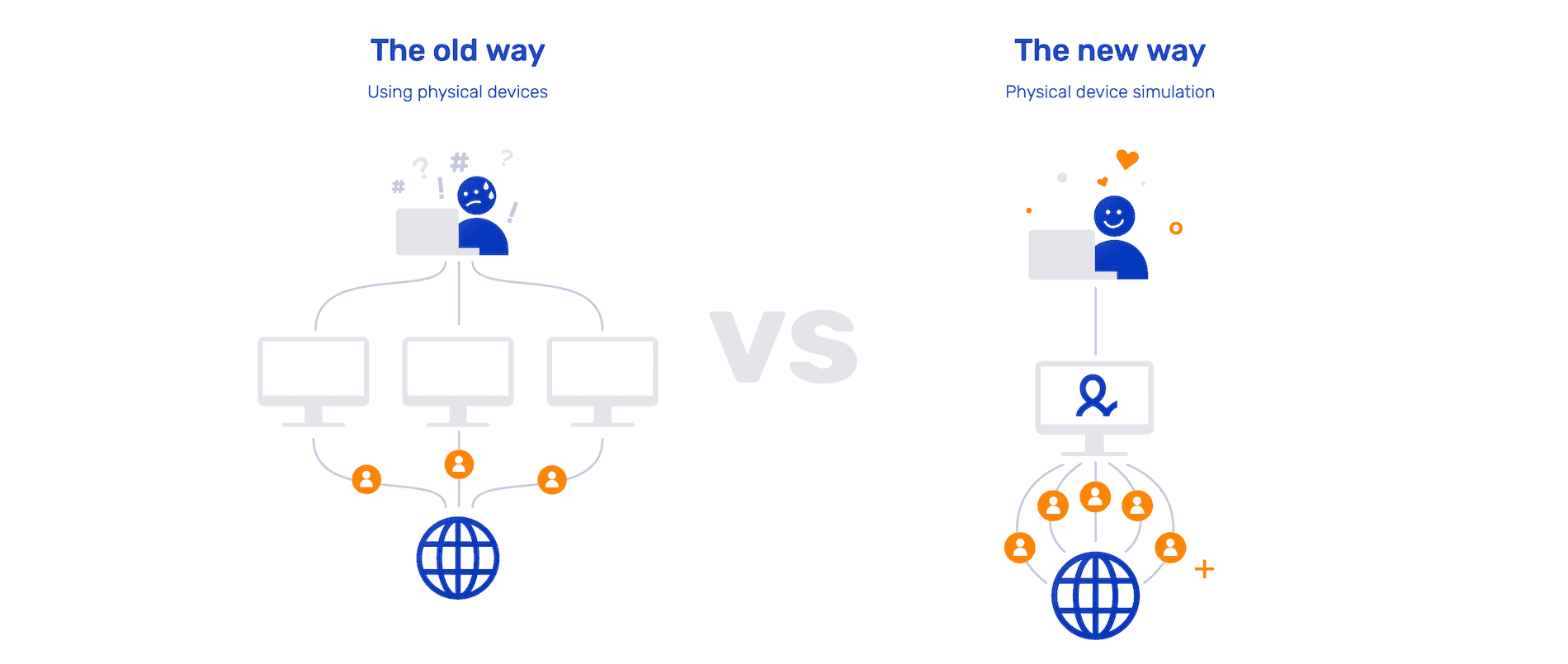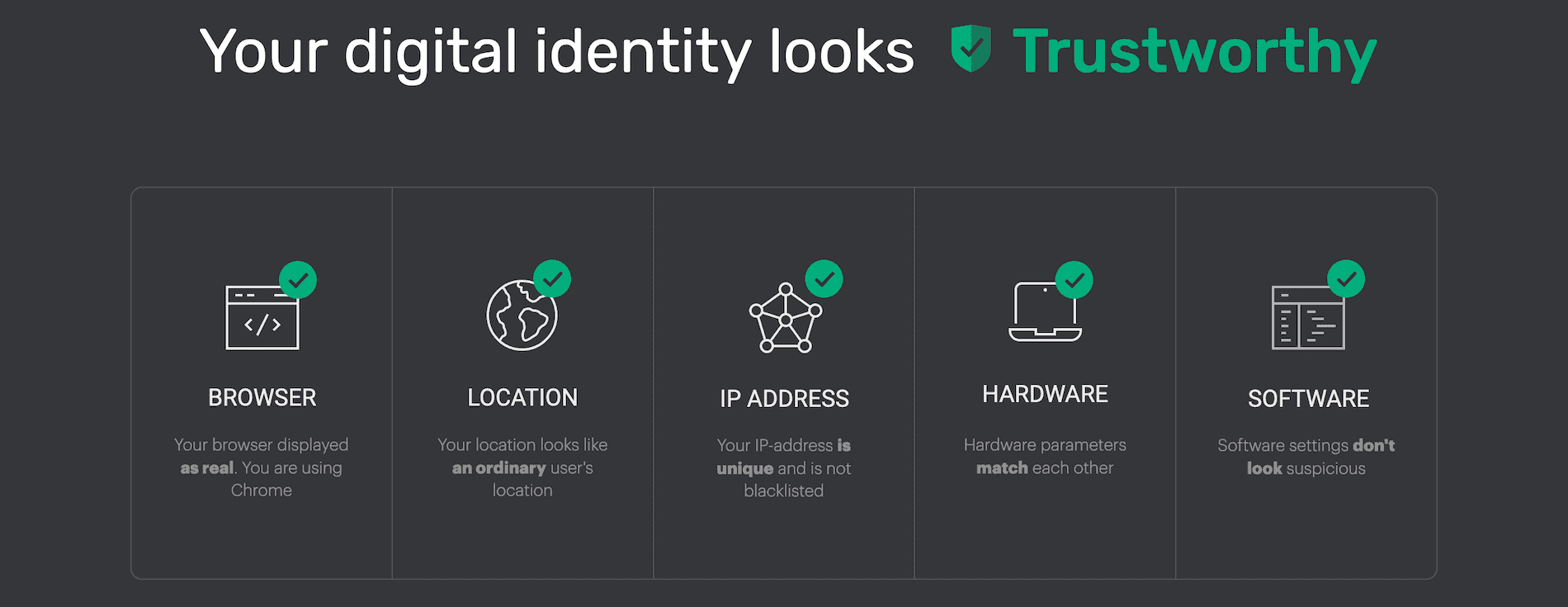A Guide to Antidetect Browsers
Remember those old spy movies where every room was bugged? They may appear paranoid now, but the internet is no better. Websites have many ways to track you without your knowledge. So, whether you want to avoid that for personal reasons, or you’re running a business that requires several different identities, antidetect browsers can help. Learn all about them here.

Browser Fingerprinting – When Proxies and VPNs Aren’t Enough
There truly are many ways to track a person online. We’re most familiar with cookies, thanks to European Union’s regulations. They save information about your device, preferences, and can follow you across several websites to log your activity or serve retargeting ads. The IP address is another well-known identifier: it’s like a license plate that reveals some information about its issuer and your location.
Cookies and IP addresses are easy to change. You can delete cookies or use a different browser profile, while a VPN or proxy server can give you a new IP address. Even better: third-party cookies are going away, which will limit how much websites will know about your browsing habits. However, every marketer that’s had to manage multiple social media or e-commerce profiles knows it’s not enough. And the reason for that is browser fingerprinting.
A browser fingerprint combines dozens of data points that comprise a device’s IP address, hardware and software parameters. They’re collected via JavaScript and other technologies like HTML5 canvas fingerprinting to create a unique profile. We can’t see them, and that’s what makes this tracking method so devious.
Individual data points say little about us. But taken together, they can accurately identify a device from hundreds of thousands of users. You can try it yourself by visiting the AmIUnique project.
Ironic as it may sound, many of the privacy measures you can take (such as using an ad blocker or switching to a less popular but more private browser) only make you easier to distinguish from the crowd. Blending in is the best option to remain unnoticed.

Antidetect Browsers to the Rescue
This is where antidetect browsers come in. Their purpose is to fight against tracking and profiling, so that you can carry out your activities in private. But what exactly is an anti-detect browser, and how does it differ from regular web browsers?
From the technical standpoint, there are few differences – an antidetect browser has the same innards as regular Chrome or Firefox. In fact, it might as well be Chrome or Firefox, if not for one feature: it allows creating completely separate browser profiles.
You might think: wait a minute, Chrome lets me have multiple browser profiles already! True, but not to the same extent – they can still be associated by your IP, hardware, and other details. An anti detection browser completely changes your digital fingerprint to make it seem like a different person is connecting from a different device. This lets you have separate environments that can’t be linked to one another.
Antidetect browsers aren’t the only tool to keep your digital identities private. However, they’re easier to handle than running multiple different devices or virtual operating systems. You can also share the profiles with others, which comes in very handy for marketing agencies that manage multiple accounts. Antidetect browser Multilogin illustrates the point well:

How an Antidetect Browser Works
An antidetect browser creates separated browsing environments by manufacturing digital fingerprints for each of the profiles you make. This isn’t done at random: the fingerprint is intentionally made as generic as possible, but also different from the one your device has.
I’ve mentioned that a browser fingerprint comprises dozens of data points. They include things like your user agent, operating system, IP address and location, graphics card, installed fonts, plugins, and more. Many of them are related to one another. So the art – and biggest challenge – of antidetect browsers is to make sure that the puzzle checks out.
Overall, the data points can be broadly put into five large buckets: browser information, location data, IP address, hardware, and finally software settings. An antidetect browser covers all but one – IP address. You’ll need to buy some proxy IPs to complete the picture or use the Tor network if the browser supports it. We write more about proxies here.

What People Use Them For
It’s easy to spin antidetect browsers as stalwart defenders of privacy. Ones that help netizens protect themselves from the prying eyes of big corps. I don’t deny that some really use them that way. But in reality, their main purpose is commercial – to help businesses and marketers control multiple accounts on platforms that forbid it. This has value for:
- Social media agencies that need to manage hundreds of client accounts from various locations and devices. Using a stable browser fingerprint for account management reduces burdersome verifications and prevents blocks.
- Affiliate marketers that create multiple social media, forum, and ad accounts to increase the reach of their affiliate links.
- E-commerce managers that want diversify risk by running several unrelated Amazon, eBay and payment processor profiles.
- Dropshippers that similarly want to expand their online business throughout several stores without linking them to one another.
- Advertisers that want to cover more ground by running ads via multiple Google AdWords or Facebook Business accounts. Frankly, it’s often for arbitration purposes (buying traffic cheap and reselling expensive), which is ethically questionable.
Creators of antidetect browsers also try to sell them as handy tools for developers. They can be used for:
- Web scraping dynamically generated websites or domains with fingerprint-based tracking. One multi-profile browser in theory should use less resources than running many instances of headless browsers.
- Web testing by emulating various parameters like the browser engine or screen size.
Of course, being anonymity tools, antidetect browsers also find themselves aiding black-hat activities. For example, they’re a popular choice among carders that need to bypass anti fraud systems for checking stolen credit card credentials via different identities.
How to Use an Antidetect Browser
All this talk about fingerprints may seem intimidating, but antidetect browsers are pretty straightfoward to use. Here are the usual steps involved:
- Create a new profile. Most modern browsers generate browser fingerprints automatically, so you only need to enter a few parameters: the profile’s name, your preferred operating system, location, and the proxy server’s credentials if needed.
- Customize the profile (optional). If you want, you can further tinker with individual settings. They range from user agent and monitor resolution to plugins and hardware parameters. You can also import cookies with login information and website preferences.
- Run the profile. Simply press a button, and a new browser window will open. It will look and function like regular Chrome or Firefox.
- Share the profile (optional). Some antidetect browsers support browser profile sync, which allows to share browser configurations with others. So, several people can control the same user from different locations and devices.

Are Antidetect Browsers Infallible?
They’re not. Emulating a browser’s fingerprint is no easy feat, and not every antidetect browser manages to achieve that perfectly. Sometimes, security can be compromised by necessary choices, such as selecting a different operating system than the one you’re running.
In late 2020, a researcher tested multiple internet browsers that offer anti-detection features. Every one of them had some kind of flaw that gave them away.
However, this doesn’t mean that antidetect browsers don’t work. They have done well for many Amazon merchants, Instagram marketers, and Google advertisers. It just shows that you can’t have complete confidentiality in such tools against an actor who’s actively looking to compromise them.
Where to Get One
If you’ve decided to try out an antidetect browser, the market won’t leave you lacking. There’s about a dozen different companies offering the same thing – to help you control multiple identities. Some offer a free trial or a set number of free profiles, and the starting price ranges from $29-100 per month. A more expensive plan supports bulk account creation, together with profile sync.
You’ll find websites that don’t pass the smell test if you’re not Russian or Chinese. That doesn’t mean they don’t work, but it’s a good idea to be cautious. TrustPilot and other review aggregators will offer limited help. If you have time, the BlackHatWorld forum (despite its name) can be a great source of information. Or, you can read our list of the best antidetect browsers and take your pick.
Conclusion
An antidetect browser is a powerful tool for improving anonymity and managing multiple online identities. While it can be used for fraud and illegal purposes, many marketers rely on antidetect browsers to run their businesses.